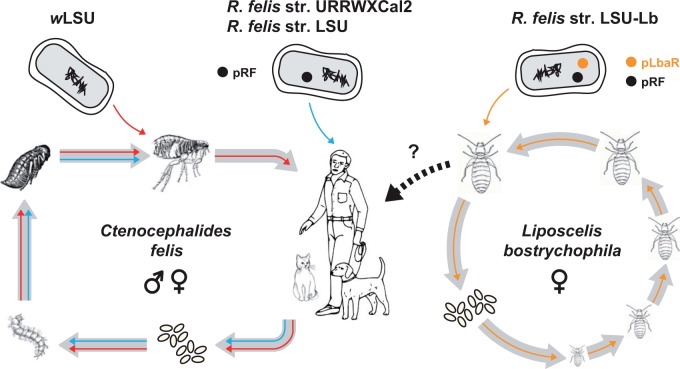Fig. 5.—
Modes of infection and transmission of divergent R. felis strains in fleas and booklice. As opportunistic pathogens, R. felis strains URRWXCal2 and LSU are shown infecting vertebrate hosts (center). Such infection would occur by a blood-feeding arthropod (e.g., tick or mite) or by flea-fecal contamination of bites on the skin. The life cycle of the cat flea, C. felis, is shown (left), with an adult insect harboring a Wolbachia symbiont (top left). After feeding on a vertebrate host that is infected with R. felis, eggs are laid that contain both Wolbachia and R. felis. Both parasites are transmitted transstadially throughout the holometabolous life cycle (egg–larva–pupa–adult). Adults feed again on an uninfected vertebrate host, with transovarial transmission of R. felis and Wolbachia. The life cycle of the parthenogenic booklouse, L. bostrychophila, is shown (right), with an adult female infected by R. felis str. LSU-Lb. Rickettsia are transmitted transovarially and transstadially throughout the stages of the paurometabolous life cycle (egg–nymphal stages (1–4)–adult). Although rickettsial infection of L. bostrychophila occurs at 100% frequency throughout populations across the world, superinfection by different R. felis strains is plausible given the presence of rickettsia in ovaries, oocytes, fat bodies, and digestive tracts. Such superinfection is predicted to occur due to the niche overlap of C. felis and L. bostrychophila, with booklice feeding on dead fleas and flea eggs that contain other strains of R. felis. The ability of R. felis str. LSU-Lb. to infect vertebrates (dashed arrow) is unknown, but would involve inhalation or dermal inoculation of booklouse feces (see text for further details).

